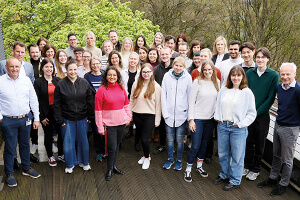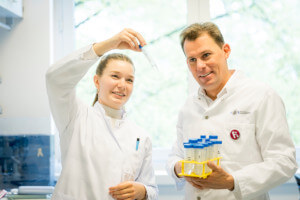
New knowledge in pediatric brain tumor research
ATRTs (atypical teratoid / rhabdoid tumors) are rare, but highly aggressive malignant diseases of the central nervous system in childhood that often occur in the first twelve months of life. Genetic causes of these tumors are mutations in SMARCB1 (over 95%) or - much less - in SMARCA4, which lead to the inactivation of the respective gene product. In the SMARCA4 mutated cases, scientists assume a higher frequency of germline mutations, a younger age of the patients and a presumably even worse prognosis compared to SMARCB1-deficient ATRTs - but molecular data supporting these differences were still missing.
Based on their DNA methylation profiles and their gene expression, SMARCB1-mutated ATRTs are divided into three different molecular subgroups: ATRT-TYR, ATRT-SHH and ATRT-MYC. These differ in terms of age at diagnosis, tumor location, type of SMARCB1 changes, and overall survival. It was unclear, whether the much less well investigated ATRT-SMARCA4 can be counted to one of the described ATRT subgroups, and if yes, to which one. In the frame of an international team effort, Dr. Dörthe Holdhof from the Schüller group has now succeeded in creating clarity here. The team was able to show that the samples form a separate subgroup within the rhabdoid tumors and that these are molecularly distinct from SMARCB1-mutated ATRTs and also from SMARCA4-deficient extracranial rhabdoid tumors. For example, the level of global DNA methylation in ATRT-SMARCA4 is significantly reduced and the signature genes of the established subgroups in these tumors are not upregulated.
For the investigation, the collected the largest ATRT-SMARCA4 series to date with a number of 14 samples. In addition, they made use of a molecular biological characterization of the ATRT-SMARCA4 for the first time by performing global DNA methylation analyzes and RNA sequencing. "The rare entities show us how far we are from the complete recording and understanding of childhood brain tumor entities," explains Dörthe Holdhof. “Classification levels always have a prognostic and therapeutic relevance. We hope that our research paves the way for further investigations, which will ultimately lead to improved diagnostics and new therapeutic options. ”The data are published in the current issue of the journal Acta Neuropathologica. Click here for the publication (Acta Neuropathologica https://doi.org/10.1007/s00401-020-02250-7)


















